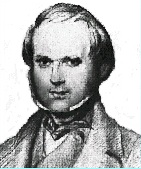Readings on: The theory of evolution–– results and significance
Darwin, Charles The Origin of Species (1859)[The Origin of Species is a sustained argument supported by a wealth of evidence. The following passages are taken from different parts of the book.] [abstract– 380 words]
It is observed that in nature animals and plants of the same species exhibit variation. By selecting desirable variations, human beings develop domestic animals and plants. In the struggle for life nature selects those variations that are profitable to the individuals of a species. That is, those variations that tend to help the preservation of such individuals will generally be inherited and preserved in the offspring.
Since more individuals are produced than can possibly survive, there must in every case be a struggle for existence. The slightest differences of structure or constitution may make a difference in the struggle for life, and so be preserved.
There is also sexual selection. This is a struggle for the possession of the other sex. Generally, the most vigorous males, those that are best fitted for their places in nature, will leave most progeny.
There are, indeed, some difficulties with the theory. But they are more apparent than real. To suppose that the eye, for example, with its many component parts could have been formed by natural selection seems absurd. But there are numerous gradations from a simple eye to a complex one. If each gradation is useful to its possessor, the eye varies, and the variations are inherited, then a perfect and complex eye could be formed by natural selection.
In living bodies, variation will cause the slight alterations, generation will multiply them almost infinitely, and natural selection will pick out with unerring skill each improvement. Let this process go on for millions of years, and the perfection we see about us will be the natural result.
The theory of natural selection can explain why the hand of a man, the foreleg of a mole, the leg of the horse, the paddle of the porpoise, and the wing of the bat, are all constructed on the same pattern, and include similar bones, in the same relative positions.
Animals and plants vary. Even though it is ever so slightly or slowly, variations or individual differences, which are in any way beneficial, will be preserved and accumulated through natural selection, or the survival of the fittest. There is no limit to this power, acting during long ages, favoring the good and rejecting the bad, in slowly and beautifully adapting each form to the most complex relations of life.


